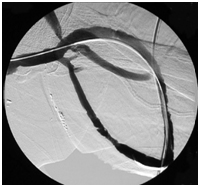VENOUS ANGIOPLASTY INDIA SURGERY BANGALORE
 Sensory ataxia is both a symptom and a sign in neurology. It is a form of ataxia (loss of coordination) caused not by cerebellar dysfunction but by loss of sensory input into the control of movement.
Sensory ataxia is both a symptom and a sign in neurology. It is a form of ataxia (loss of coordination) caused not by cerebellar dysfunction but by loss of sensory input into the control of movement.
Sensory ataxia is distinguished from cerebellar ataxia by the presence of near-normal coordination when the movement in question is visually obser ved by the patient, but marked worsening of coordination when the eyes are closed.
Sensory ataxia also lacks the associated features of cerebellar ataxia such as pendular tendon reflexes, scanning dysarthria, nystagmus and broken pursuit eye movements.
Patients with sensory ataxia often demonstrate pseudoathetosis and Romberg’s sign. They usually complain of loss of balance in the dark, typically when closing their eyes in the shower or removing clothing over the head.
Narrowed or blocked large veins can cause severe swelling and pain. Venous angioplasty is a procedure done to treat these blockages.
Before the Procedure Surgery in india
Follow any instructions you are given on how to prepare, including : –
- Do not eat or drink anything for 6 hours before the procedure.
- Tell your radiologist what medications, herbs, or supplements you take; if you are, or may be, pregnant; or if you are allergic to contrast medium (x-ray dye) or other medications.
During the Procedure Surgery in india
- You’ll change into a hospital gown and lie on an x-ray table. An IV (intravenous) line is started to give you fluids and medications. You may be given medication to help you relax. The skin at the insertion site is numbed with medication.
- A very small incision is made over the insertion site. Then, a needle with a thin guide wire is inserted through the skin into the vein. A catheter (thin, flexible tube) is placed over the guide wire into the blood vessel.
- Contrast medium is injected into the blood vessel. This helps the veins show clearly on x-ray images. Using these images as a guide, the radiologist moves the catheter to the narrowed or blocked part of the vein.
- When the catheter reaches the narrowed or blocked area, a special balloon attached to the catheter is inflated (angioplasty). This widens the passage through the vein.
- To hold the vein open, a stent may then be inserted. To do this, a catheter with a stent attached is threaded over the guide wire. When the stent reaches the narrowed area, it is opened fully. The stent stays in the artery and the catheters and balloons are removed.
- When the procedure is done, the catheter, wire, and balloons are removed. The stent remains in place.
Potential Risks and Complications
- Bruising at the catheter insertion site
- Damage to the vein, including worsening of blockage
- Problems due to contrast medium, including allergic reaction or kidney damage
- Restenosis (reblockage) of the artery, often within 6 to 18 months
After the Procedure
- You may stay in the hospital for a few hours or overnight.
- Drink plenty of fluids to help flush the contrast medium from your system.
- Care for the insertion site as directed.







